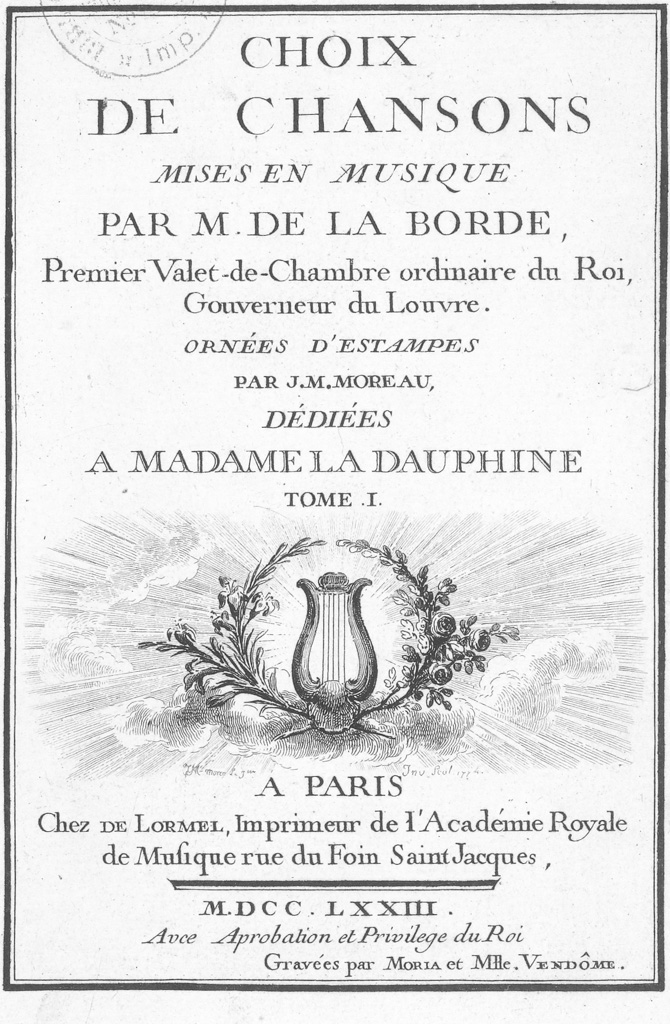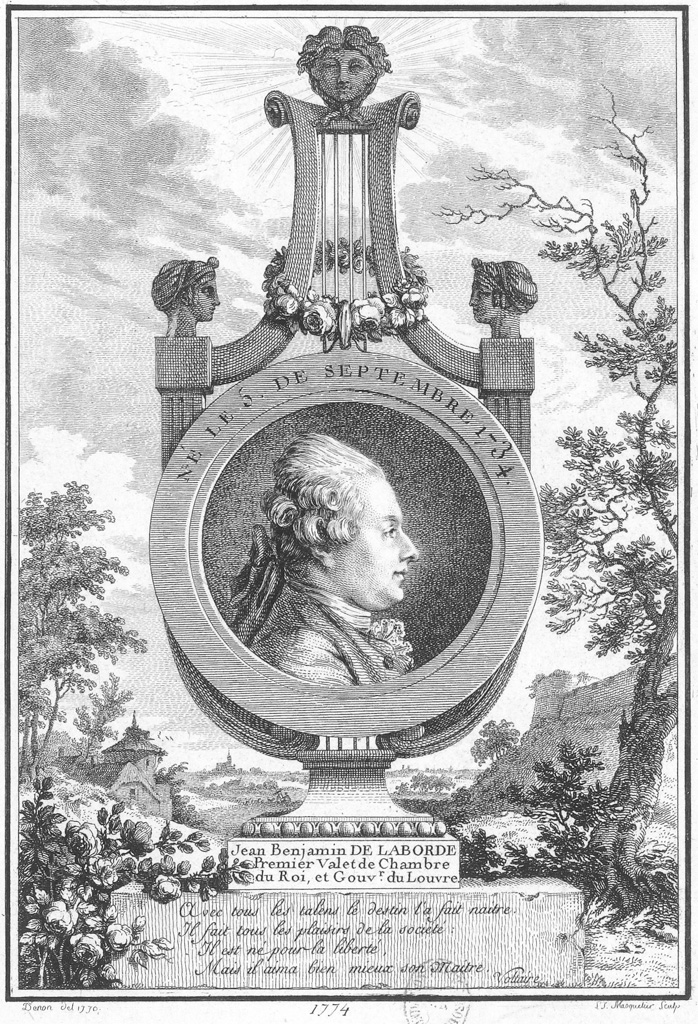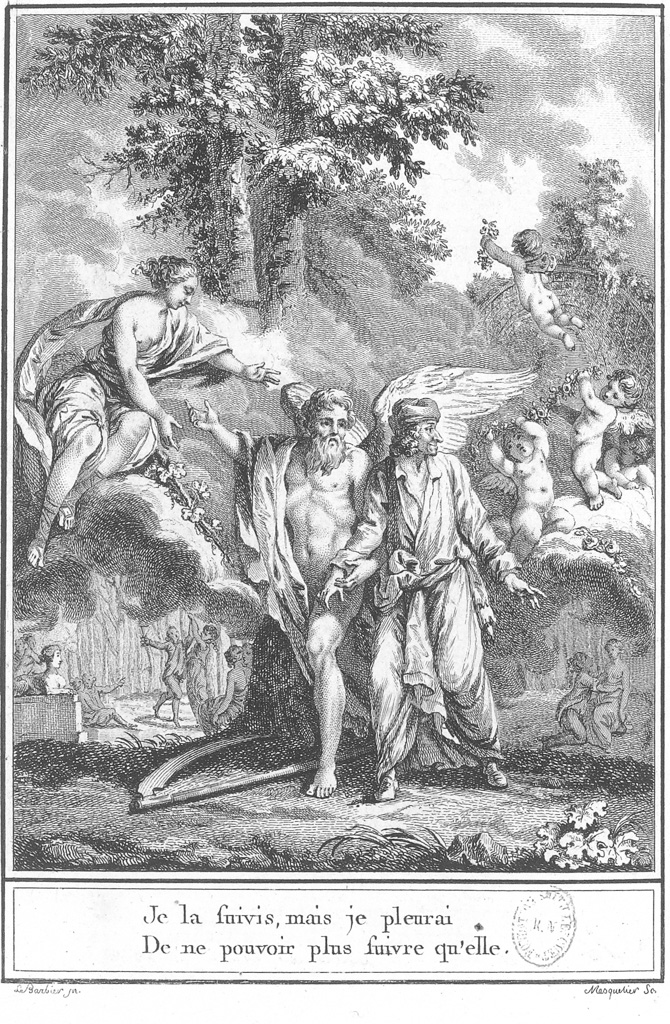
The Enlightenment was the golden age of book illustration in France. Traditionally, studies of eighteenth-century illustrated books were the province of amateurs and bibliophiles who delighted in deluxe editions and wrote of the engravings they contained as splendid rococo follies, reflecting the decorative impulse of a lost courtly age. This approach, however, has marginalized the contribution of these artists through a failure to interrogate the significant sociological dimensions of their illustrated books and their participation in complex networks of production and reception.
One of the best-known illustrated songbooks of the later eighteenth century is the four-volume Choix de Chansons compiled by Laborde (1734–1794), fermier général and premier valet de chambre to Louis XV. Published in 1773 and dedicated to the Dauphine, Marie Antoinette, this deluxe set is an exemplary work of hybrid performativity. It includes printed text from leading contemporary poets, including Voltaire, more than a hundred pictorial engravings, and hand-engraved musical scores for voice and harp or harpsichord. Its author, Laborde, was an avid musician, composer, musicologist, and Freemason. While remaining a noted member of Louis XV’s court, he corresponded with some of the most prominent intellectual figures of the period.

The songs selected by Laborde in his Choix de Chansons are by a variety of French poets whose subjects provide an extraordinarily wide panorama of eighteenth-century life. Laborde commissioned the celebrated print-maker, Jean-Michel Moreau (1741-1814), known as Moreau le Jeune. Moreau contributed only twenty-five plates to the four-volume set, however, with three other illustrators completing the project (Le Bouteux, Le Barbier, and Saint-Quentin). Although the work is dedicated to Marie Antoinette, many contributors to the Chansons, especially Moreau and Voltaire, were socially progressive, both men having belonged to the radical Masonic Loge des Neuf Sœurs. Scholars have argued, for instance, that the same moral sensibility found in a thinker such as Jean-Jacques Rousseau can also be found in Moreau le Jeune’s printed œuvre. Laborde’s Choix de Chansons thus distils the dynamic sensibilities of late-eighteenth century France, embodying both the exuberance of the Court and the enlightened mores of the philosophes.

Our contention then is that the Choix de Chansons – to be fully appreciated – must be understood in its deeply multi- or trans-disciplinary historical context. As Julia Douthwaite and Mary Vidal have shown, the eighteenth century was perhaps the last truly ‘interdisciplinary century’. It was a time when artists, musicians, poets, jurists, mathematicians, philosophers, and diverse audiences worked together to produce new interdisciplinary practices that explored the fundamental inter-connectedness of the arts and sciences. Music was admired as much for its harmonic science as its compositional beauty; and the visual arts became an important point of entry into contemporary debates about the mechanics of aesthetic experience, in part stimulated by the new branch of physics called ‘optics’ that had developed in the wake of Descartes and Newton. Nowhere is this interdisciplinary gesture more evident than in the great mid-century Encyclopédie, a collaborative reference work edited by Denis Diderot and Jean D’Alembert that explicitly sought to establish epistemological correspondences between the arts, natural sciences, and technical trades.
In order to recapture the fundamentally interdisciplinary aspects of eighteenth-century cultural production, we aim to move beyond our normal areas of specialisation to explore the Choix de Chansons through a ‘transdisciplinary’ lens. The transdisciplinary approach aims to integrate disciplinary knowledge into a meaningful whole, one that implies a system of interrelated knowledge without established disciplinary boundaries that only becomes visible when brought together; a system that in fact has much in common with that imagined by Diderot and D’Alembert in the Encyclopédie. We propose that the Choix de Chansons is, like the Encyclopédie, in many ways a quintessential transdisciplinary object. As such, it requires a new methodological approach that operates at the interface of interdisciplinary collaboration, rich historical contextualization, and new media dissemination.
Le dernier parti a prendre from Jean-Benjamin de Laborde, ‘Choix de Chansons’ (1773). Music by Laborde, lyrics by Voltaire.
Through the digital editing and analysis of Laborde’s Choix de Chansons we will ‘perform transdisciplinarity’ in a way that both forges spaces for knowledge discovery and sharing and elucidates eighteenth-century practices of cultural production. To achieve these goals, we will develop a digital interface that acts as a holistic framework to enrich our understanding of the Choix de Chansons as well as other, similarly complex cultural objects and, more generally, of the performative nature of the cultural experience in eighteenth-century France. Working with design specialists at the ANU School of Art and Design, we are constructing a transdisciplinary data model and interface that can be applied to future humanities research across a variety of disciplines, including art history, literary studies, musicology, visual culture, book history, and digital humanities.

Our first major presentation of Performing Transdisciplinarity was delivered at the British Society for Eighteenth Century Studies (BSECS) conference in January this year as part of the panel, ‘Unboxing Jean Benjamin Laborde’s “Choix de Chansons” (1773) – ancien-régime sociability and the possibilities of the digital humanities.’ Conference delegates were also treated to a recital of eight songs from Laborde’s book, sung by Emilie Renard and accompanied by Erin Helyard on Harpsichord (see video link above). Further developments of this project can be found on the Voltaire Lab page.
– Glenn Roe and Robert Wellington





